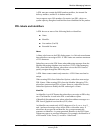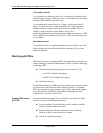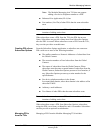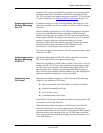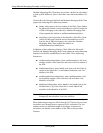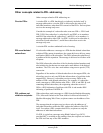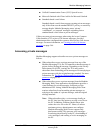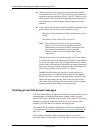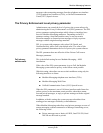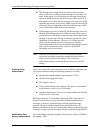
Modular Messaging features
November 2004
Avaya Modular Messaging Concepts and
Planning Guide
5-41
Other concepts related to PDL addressing
Other concepts related to PDL addressing are:
Circular PDLs A circular PDL is a PDL that directly or indirectly includes itself. A
message addressed to a circular PDL is delivered to the union of all
individual members, other than PDLs on each of the PDLs. Each recipient
receives the message only once.
Consider the example of a subscriber who owns two PDLs—PDL1 and
PDL2. PDL1 has subscriber A, subscriber B, and PDL2 as its members
and PDL2 has subscriber B, subscriber C, and PDL1 as its members. A
message addressed to either PDL1 or PDL2 is delivered to subscriber A,
subscriber B, and subscriber C, and all three subscribers receive the
message only once.
A circular PDL can have unlimited levels of nesting.
PDLs and deleted
subscribers
If a subscriber addresses a message to a PDL that has deleted subscribers
or deleted PDLs among its members, the system delivers a delivery status
notification (DSN) to the subscriber. This DSN informs the subscriber of
a problem with list expansion. The message is delivered to all other valid
recipients.
The DSN informs the subscriber of the list that has deleted members and
also includes the last known text name and e-mail address of the deleted
members. The TUIs voice the e-mail address using text-to-speech (TTS)
conversion.
Regardless of the number of deleted subscribers in the targeted PDL, the
subscribers receives only one DSN that informs them of a problem in the
targeted PDL. However, a subscriber receives as many DSNs as the
number of PDLs with deleted subscribers. For example, if a subscriber
sends a message to a PDL that has other PDLs—PDL A and PDL B, each
containing deleted subscribers, the originating subscriber receives 2
DSNs: a DSN informing of problems with PDL A and another DSN
informing of problems with PDL B.
PDL address not
visible to recipients
When subscribers send a message to a PDL from the Modular Messaging
TUIs, Microsoft Outlook with Client Add-in for Microsoft Outlook, or
Modular Messaging Web Client, recipients cannot see the address of the
PDL.
The message that the recipient receives shows only the addresses of
individual subscribers within the PDL, and not the address of the PDL
itself. Even when a PDL contains other PDLs, recipients see only the
addresses of individual subscribers.
If a PDL is copied on a message using Blind Carbon Copy (BCC),
provided BCC is available to the sending client, the recipient sees neither
the PDL itself nor any of the PDL members.





